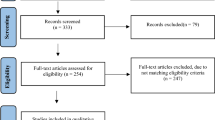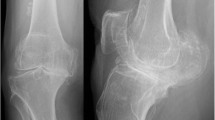Abstract
Restoration of the mechanical leg axis and component positioning are crucial factors affecting long-term results in total knee arthroplasty (TKA). In a prospective study, 1,000 patients were operated on either using a CT-free navigation system or the conventional jig-based technique. Leg alignment and component orientation were determined on postoperative X-rays. The mechanical leg axis was significantly better in the computer-assisted group (95%, within ±3° varus/valgus) compared to the conventional group (74%, within ±3° varus/valgus) (P < 0.001). On average, the operating time was increased by 8 min in the computer-assisted group. No significant differences were seen between senior and younger surgeons regarding postoperative leg alignment and operating time. Computer-assisted TKA leads to a more accurate restoration of leg alignment and component orientation compared to the conventional jig-based technique. Potential benefits in long-term outcome and functional improvement require further investigation.



Similar content being viewed by others
References
Laskin RS (2001) The Genesis total knee prosthesis: a 10-year followup study. Clin Orthop Relat Res 388:95–102
Rodriguez JA, Bhende H, Ranawat CS (2001) Total condylar knee replacement: a 20-year followup study. Clin Orthop Relat Res 388:10–17
Scott WN, Rubinstein M, Scuderi G (1988) Results after knee replacement with a posterior cruciate-substituting prosthesis. J Bone Joint Surg Am 70(8):1163–1173
Robertsson O, Knutson K, Lewold S, Lidgren L (2001) The Swedish Knee Arthroplasty Register 1975–1997: an update with special emphasis on 41,223 knees operated on in 1988–1997. Acta Orthop Scand 72(5):503–513
Jeffery RS, Morris RW, Denham RA (1991) Coronal alignment after total knee replacement. J Bone Joint Surg Br 73(5):709–714
Rand JA, Coventry MB (1988) Ten-year evaluation of geometric total knee arthroplasty. Clin Orthop Relat Res 232:168–173
Ritter MA, Faris PM, Keating EM, Meding JB (1994) Postoperative alignment of total knee replacement. Its effect on survival. Clin Orthop Relat Res 299:153–156
Petersen TL, Engh GA (1988) Radiographic assessment of knee alignment after total knee arthroplasty. J Arthroplasty 3(1):67–72
Mahaluxmivala J, Bankes MJ, Nicolai P, Aldam CH, Allen PW (2001) The effect of surgeon experience on component positioning in 673 Press Fit Condylar posterior cruciate-sacrificing total knee arthroplasties. J Arthroplasty 16(5):635–640
Mielke RK, Clemens U, Jens JH, Kershally S (2001) Navigation in knee endoprosthesis implantation—preliminary experiences and prospective comparative study with conventional implantation technique. Z Orthop Ihre Grenzgeb 139(2):109–116
Bathis H, Perlick L, Tingart M, Luring C, Grifka J (2004) CT-free computer-assisted total knee arthroplasty versus the conventional technique: radiographic results of 100 cases. Orthopedics 27(5):476–480
Perlick L, Bathis H, Tingart M, Perlick C, Grifka J (2004) Navigation in total-knee arthroplasty: CT-based implantation compared with the conventional technique. Acta Orthop Scand 75(4):464–470
Jenny JY, Clemens U, Kohler S, Kiefer H, Konermann W, Miehlke RK (2005) Consistency of implantation of a total knee arthroplasty with a non-image-based navigation system: a case–control study of 235 cases compared with 235 conventionally implanted prostheses. J Arthroplasty 20(7):832–839
Bargren JH, Blaha JD, Freeman MA (1983) Alignment in total knee arthroplasty. Correlated biomechanical and clinical observations. Clin Orthop Relat Res 173:178–183
Hood RW, Vanni M, Insall JN (1981) The correction of knee alignment in 225 consecutive total condylar knee replacements. Clin Orthop Relat Res 160:94–105
Hvid I, Nielsen S (1984) Total condylar knee arthroplasty. Prosthetic component positioning and radiolucent lines. Acta Orthop Scand 55(2):160–165
Sparmann M, Wolke B, Czupalla H, Banzer D, Zink A (2003) Positioning of total knee arthroplasty with and without navigation support. A prospective, randomised study. J Bone Joint Surg Br 85(6):830–835
Haaker RG, Stockheim M, Kamp M, Proff G, Breitenfelder J, Ottersbach A (2005) Computer-assisted navigation increases precision of component placement in total knee arthroplasty. Clin Orthop Relat Res 433:152–159
Decking R, Markmann Y, Fuchs J, Puhl W, Scharf HP (2005) Leg axis after computer-navigated total knee arthroplasty: a prospective randomized trial comparing computer-navigated and manual implantation. J Arthroplasty 20(3):282–288
Anderson KC, Buehler KC, Markel DC (2005) Computer assisted navigation in total knee arthroplasty: comparison with conventional methods. J Arthroplasty 207(Suppl 3):132–138
Chin PL, Yang KY, Yeo SJ, Lo NN (2005) Randomized control trial comparing radiographic total knee arthroplasty implant placement using computer navigation versus conventional technique. J Arthroplasty 20(5):618–626
Kim SJ, MacDonald M, Hernandez J, Wixson RL (2005) Computer assisted navigation in total knee arthroplasty: improved coronal alignment. J Arthroplasty 207(Suppl 3):123–131
Bolognesi M, Hofmann A (2005) Computer navigation versus standard instrumentation for TKA: a single-surgeon experience. Clin Orthop Relat Res 440:162–169
Stockl B, Nogler M, Rosiek R, Fischer M, Krismer M, Kessler O (2004) Navigation improves accuracy of rotational alignment in total knee arthroplasty. Clin Orthop Relat Res 426:180–186
Chauhan SK, Scott RG, Breidahl W, Beaver RJ (2004) Computer-assisted knee arthroplasty versus a conventional jig-based technique. A randomised, prospective trial. J Bone Joint Surg Br 86(3):372–377
Delp SL, Stulberg SD, Davies B, Picard F, Leitner F (1998) Computer assisted knee replacement. Clin Orthop Relat Res 354:49–56
Novotny J, Gonzalez MH, Amirouche FM, Li YC (2001) Geometric analysis of potential error in using femoral intramedullary guides in total knee arthroplasty. J Arthroplasty 16(5):641–647
Reed SC, Gollish J (1997) The accuracy of femoral intramedullary guides in total knee arthroplasty. J Arthroplasty 12(6):677–682
Laskin RS (2003) New techniques and concepts in total knee replacement. Clin Orthop Relat Res 416:151–153
Plaskos C, Hodgson AJ, Inkpen K, McGraw RW (2002) Bone cutting errors in total knee arthroplasty. J Arthroplasty 17(6):698–705
Bathis H, Perlick L, Tingart M, Perlick C, Luring C, Grifka J (2005) Intraoperative cutting errors in total knee arthroplasty. Arch Orthop Trauma Surg 125(1):16–20
Patel DV, Ferris BD, Aichroth PM (1991) Radiological study of alignment after total knee replacement. Short radiographs or long radiographs? Int Orthop 15(3):209–210
Bathis H, Shafizadeh S, Paffrath T, Simanski C, Grifka J, Luring C (2006) Are computer assisted total knee replacements more accurately placed?: A meta-analysis of comparative studies. Orthopade 35(10):1056–1065
Acknowledgments
We wish to acknowledge the work of Stefan Zeidler and Jochen Wolfsteiner in analysing the radiographs. The study complies with the current laws of the country in which they were performed.
Author information
Authors and Affiliations
Corresponding author
Additional information
Markus Tingart, Christian Lüring and Holger Bäthis contributed equally to this paper.
Rights and permissions
About this article
Cite this article
Tingart, M., Lüring, C., Bäthis, H. et al. Computer-assisted total knee arthroplasty versus the conventional technique: how precise is navigation in clinical routine?. Knee Surg Sports Traumatol Arthr 16, 44–50 (2008). https://doi.org/10.1007/s00167-007-0399-4
Received:
Accepted:
Published:
Issue Date:
DOI: https://doi.org/10.1007/s00167-007-0399-4




